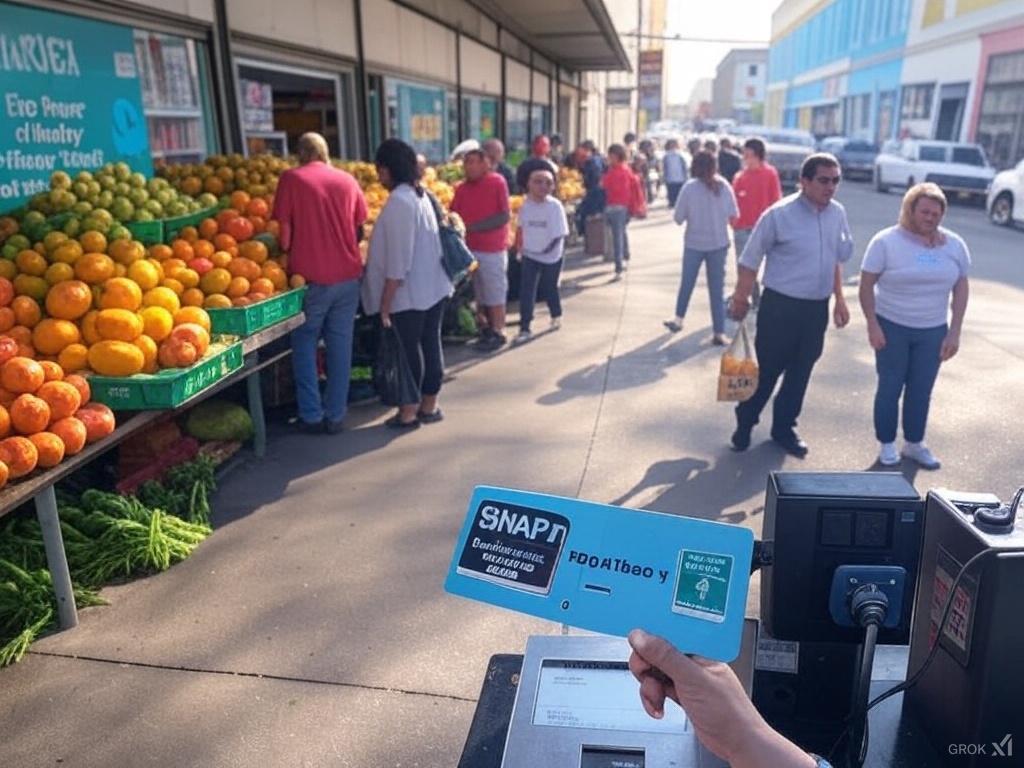
Split illustration showing two contrasting downtown scenes. Left side: a dull, rundown mini market with shelves of junk food like chips and soda, on a gray, littered street with few people. Right side: a bright, clean street with a bustling fruit and vegetable market, stalls full of fresh produce like apples and lettuce, diverse shoppers carrying bags, and renovated buildings. A cashier scans a SNAP/EBT card at the market checkout. The tagline at the bottom reads, 'Revitalizing Inner Cities: The Power of Healthy Food Access Through EBT/SNAP Restrictions.
Watertown, NY By Hans Wilder
Inner cities across the country, particularly in distressed downtown areas, often face a stark reality: an abundance of mini markets and convenience stores stocked with cheap, processed junk food, but a scarcity of fresh, nutritious options like fruits and vegetables. For communities relying on Supplemental Nutrition Assistance Program (SNAP) benefits, also known as EBT, this imbalance not only limits healthy food choices but also perpetuates cycles of poor health, economic stagnation, and urban decay. Restricting EBT/SNAP purchases to healthy foods could be a transformative step, breathing new life into these neighborhoods by encouraging the growth of fruit and vegetable markets, reducing the dominance of junk food outlets, and improving overall community well-being.
A Healthier Food Landscape
The current system allows SNAP recipients to purchase almost any food item, including sugary snacks, sodas, and highly processed foods that offer little nutritional value. While these items are often cheaper and more readily available in inner-city mini markets, they contribute to rising rates of obesity, diabetes, and other diet-related illnesses, which disproportionately affect low-income urban populations. By restricting EBT/SNAP purchases to healthier options—such as fresh produce, whole grains, lean proteins, and low-fat dairy—policymakers could incentivize a shift toward better eating habits. This change wouldn’t just benefit individuals; it would create a ripple effect, pressuring local stores to adapt their inventory to meet the new demand for nutritious foods.
As mini markets are forced to stock more fruits, vegetables, and other healthy items to remain competitive, the urban food environment would gradually transform. Over time, this could lead to the emergence of specialized fruit and vegetable markets, similar to those found in healthier, more affluent areas. These markets would not only provide better food options but also create jobs, attract foot traffic, and foster a sense of community pride. Downtown areas, often littered with neglected storefronts and fast-food chains, could see a resurgence of vitality as healthy food becomes a cornerstone of the local economy.
Addressing Accessibility Challenges
Not everyone in inner cities has the means or ability to travel to suburban areas, where large supermarkets and farmer’s markets often offer a wider variety of fresh produce. For many SNAP recipients and other government program participants, transportation barriers—such as limited access to cars, unreliable public transit, or long commutes—make regular trips to the suburbs impractical. Restricting EBT/SNAP to healthy foods would ensure that nutritious options are available closer to home, reducing the need for such journeys and making it easier for families to prioritize their health.
This approach would also level the playing field for inner-city residents, who are often trapped in “food deserts” with few alternatives to junk food. By reshaping the market incentives, policymakers could help bridge the gap between urban and suburban food access, ensuring that everyone, regardless of income or location, has the opportunity to make healthier choices.
Economic and Social Revival
The ripple effects of this policy could extend far beyond individual health outcomes. As demand for healthy foods grows, entrepreneurs might be more inclined to open fruit and vegetable markets or co-ops in downtown areas, replacing or supplementing the mini markets that currently dominate. These new businesses would not only diversify the local economy but also create jobs, from farmers and suppliers to store clerks and managers. Over time, this influx of activity could reduce crime, improve property values, and make downtowns more attractive places to live, work, and visit.
Moreover, shifting away from junk food could foster a cultural shift toward wellness in these communities. As residents gain easier access to fresh produce and education about its benefits, they might be more likely to adopt healthier lifestyles, reducing healthcare costs and improving quality of life. Schools, community centers, and local governments could partner with these new markets to offer cooking classes, nutrition workshops, and other programs, further embedding healthy eating into the fabric of urban life.
A Win for Public Health and Equity
Critics might argue that restricting EBT/SNAP purchases infringes on personal choice or places an unfair burden on low-income families. However, the goal isn’t to punish or limit freedom—it’s to create a system that prioritizes long-term health and equity. Junk food is already heavily marketed and subsidized, making it disproportionately affordable and accessible in low-income areas. Counterbalancing this with policies that promote healthy eating isn’t just fair; it’s necessary to address the systemic disadvantages faced by inner-city residents.
For those who rely on government programs, the ability to purchase only nutritious foods with their benefits could be empowering. It signals a societal commitment to their well-being, acknowledging that access to healthy food is a fundamental right, not a privilege reserved for those with more resources. And as downtowns become hubs for fresh, local produce, the entire community stands to benefit—from improved public health to a renewed sense of pride and possibility.
A Path Forward
Restricting EBT/SNAP purchases to healthy foods is more than a policy change—it’s a vision for transformation. By replacing junk food-laden mini markets with vibrant fruit and vegetable markets, inner cities could see a renaissance of health, economic activity, and community spirit. For those who can’t easily shop in the suburbs, this shift would bring life-giving options closer to home, while also tackling the root causes of poor nutrition and urban decline.
The road won’t be easy, and implementation would require careful planning, community input, and support for businesses and families during the transition. But the potential rewards—a healthier population, a revitalized urban core, and a more equitable food system—are worth the effort. With the right steps, inner cities could once again become thriving centers of opportunity and well-being, proving that even small changes in policy can yield profound, lasting change.



